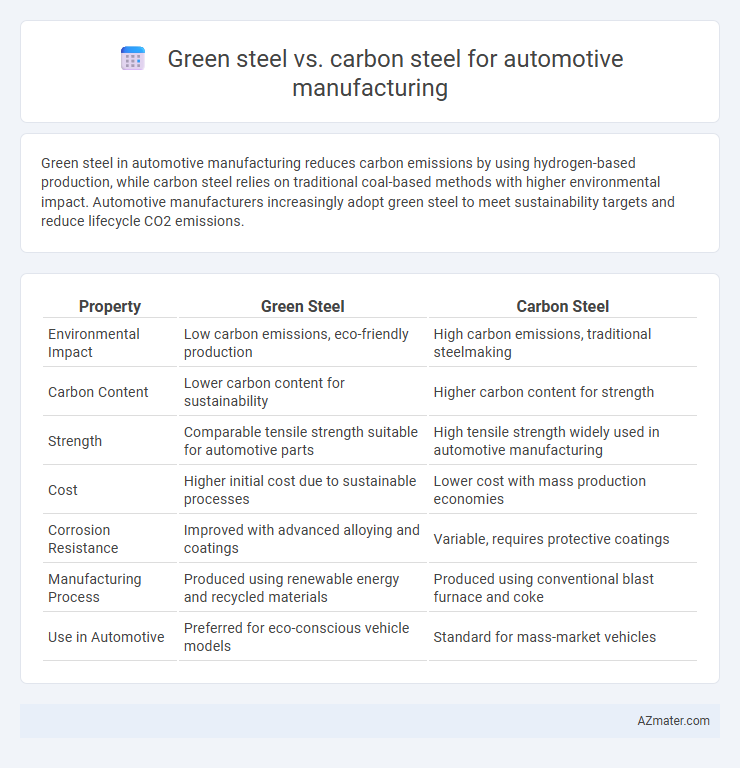Green steel in automotive manufacturing reduces carbon emissions by using hydrogen-based production, while carbon steel relies on traditional coal-based methods with higher environmental impact. Automotive manufacturers increasingly adopt green steel to meet sustainability targets and reduce lifecycle CO2 emissions.
Table of Comparison
| Property | Green Steel | Carbon Steel |
|---|---|---|
| Environmental Impact | Low carbon emissions, eco-friendly production | High carbon emissions, traditional steelmaking |
| Carbon Content | Lower carbon content for sustainability | Higher carbon content for strength |
| Strength | Comparable tensile strength suitable for automotive parts | High tensile strength widely used in automotive manufacturing |
| Cost | Higher initial cost due to sustainable processes | Lower cost with mass production economies |
| Corrosion Resistance | Improved with advanced alloying and coatings | Variable, requires protective coatings |
| Manufacturing Process | Produced using renewable energy and recycled materials | Produced using conventional blast furnace and coke |
| Use in Automotive | Preferred for eco-conscious vehicle models | Standard for mass-market vehicles |
Overview of Green Steel and Carbon Steel
Green steel, produced using renewable energy and hydrogen-based reduction, significantly reduces carbon emissions in automotive manufacturing compared to traditional carbon steel, which relies heavily on coal and coke in blast furnaces. Carbon steel remains the dominant material due to its strength, durability, and cost-effectiveness, but it contributes to substantial CO2 emissions, accounting for nearly 7-9% of global emissions. The shift towards green steel aims to meet stricter environmental regulations and automotive industry goals for sustainability while maintaining mechanical properties essential for vehicle safety and performance.
Key Differences Between Green Steel and Carbon Steel
Green steel in automotive manufacturing significantly reduces carbon emissions by using hydrogen or electric arc furnace methods, unlike traditional carbon steel produced via blast furnaces relying on coal. Green steel offers enhanced sustainability and lower environmental impact while maintaining comparable strength and durability essential for vehicle safety and performance. Cost and production scalability remain challenges, but growing demand for carbon-neutral materials is accelerating green steel adoption in the automotive sector.
Environmental Impact: Green Steel vs Carbon Steel
Green steel significantly reduces carbon emissions by utilizing hydrogen-based direct reduction and renewable energy sources, lowering the automotive industry's environmental footprint. In contrast, traditional carbon steel production relies on coal-intensive blast furnaces, generating substantial greenhouse gases and contributing to air pollution. Adopting green steel in automotive manufacturing supports sustainability goals by minimizing lifecycle carbon impacts and promoting cleaner energy integration.
Production Processes Compared
Green steel production for automotive manufacturing primarily involves using hydrogen-based direct reduced iron (DRI) or electric arc furnaces powered by renewable energy, significantly reducing carbon emissions compared to traditional methods. Carbon steel production employs blast furnaces fueled by coal or coke, generating substantial CO2 emissions during iron ore reduction and steelmaking stages. The shift toward green steel processes aims to maintain steel quality and strength standards essential for automotive components while drastically lowering the environmental impact of steel production.
Mechanical Properties and Performance
Green steel offers enhanced tensile strength and improved corrosion resistance compared to traditional carbon steel, making it highly suitable for automotive manufacturing. Its lower carbon content and advanced alloying elements contribute to superior fatigue resistance and better energy absorption during crash impacts. Consequently, vehicles manufactured with green steel often exhibit increased durability and safety performance while reducing environmental impact.
Cost Analysis: Green Steel vs Carbon Steel
Green steel production incurs higher initial costs due to advanced technologies like hydrogen-based reduction and renewable energy usage, impacting upfront capital expenditure compared to traditional carbon steel manufacturing. However, the long-term operational expenses of green steel are potentially lower, driven by reduced carbon taxes and compliance costs amid tightening environmental regulations. Carbon steel remains cheaper in raw material and energy requirements but faces increasing financial risks due to carbon pricing and sustainability mandates in the automotive sector.
Sustainability and Lifecycle Assessment
Green steel, produced using renewable energy and hydrogen-based reduction, significantly lowers carbon emissions compared to traditional carbon steel in automotive manufacturing. Lifecycle assessments reveal green steel's reduced environmental footprint through minimized energy consumption and decreased greenhouse gas emissions during extraction, production, and end-of-life phases. Adoption of green steel aligns with sustainability goals by enhancing circular economy practices and supporting regulatory compliance in the automotive industry's decarbonization efforts.
Industry Adoption in Automotive Manufacturing
Green steel is gaining traction in automotive manufacturing due to its reduced carbon emissions and alignment with sustainability targets driven by regulatory pressure and consumer demand. Major automakers such as Volvo and BMW have initiated pilot programs incorporating green steel in their supply chains to lower the overall carbon footprint of vehicle production. In contrast, carbon steel remains dominant due to established infrastructure and cost-efficiency but faces challenges as the industry shifts toward decarbonization and stricter environmental standards.
Regulatory and Market Trends
Green steel production, utilizing hydrogen reduction and electric arc furnaces powered by renewable energy, aligns with tightening automotive industry regulations targeting CO2 emissions and sustainability goals. Carbon steel manufacturing faces increasing regulatory pressure due to its higher carbon footprint, prompting automakers to shift toward greener alternatives to meet emission standards such as the EU's Green Deal and U.S. Clean Cars Act. Market trends show a growing demand for green steel as automotive manufacturers prioritize eco-friendly materials to enhance environmental compliance and cater to consumer preference for sustainable vehicles.
Future Outlook for Green Steel in Automotive Industry
Green steel, produced using renewable energy and hydrogen-based reduction methods, offers significant potential to reduce the automotive industry's carbon footprint compared to traditional carbon steel manufacturing. With increasing regulatory pressures for sustainable materials and rising consumer demand for eco-friendly vehicles, green steel adoption is projected to grow rapidly in automotive manufacturing by 2030. Investments in green steel technologies by major automakers and steel producers highlight a strong commitment to integrating low-emission steel in electric and hybrid vehicle production, driving the industry's transition towards sustainable manufacturing.

Infographic: Green steel vs Carbon steel for Automotive manufacturing
 azmater.com
azmater.com